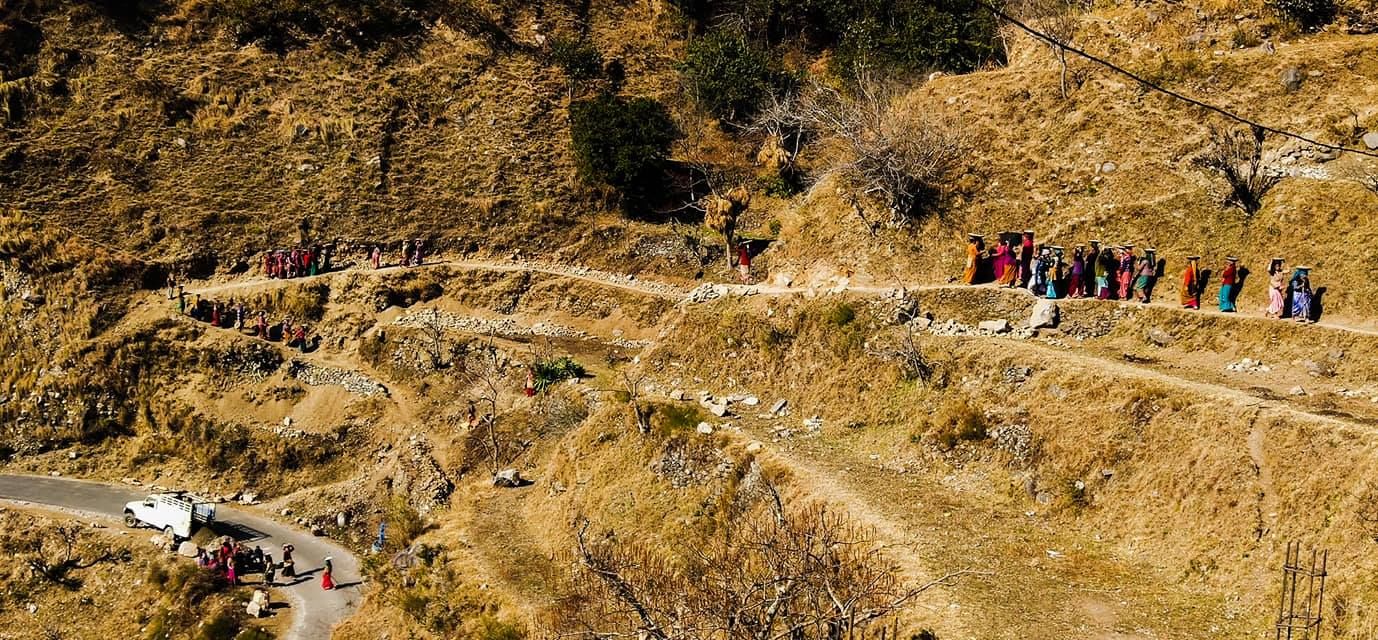Deserted hill villages in Uttarakhand come alive due to reverse migration
Close to 60,000 migrant workers have returned to their villages in the state because of the COVID-19 lockdown. This reverse migration has brought life to these hill villages forlorn for several years.


Lalit Jena left his village Bairoli in Nainital district of Uttarakhand and migrated to Delhi many years ago to work in a hotel and earn a livelihood. During the COVID-19 lockdown, when all the activities in the country came to a standstill, Jena’s hotel in the national capital was shut down, too. He had no option but to return to his village home.
“Because of no livelihood in the hills, I was forced to migrate to Delhi for work. But, when the hotel where I worked closed its door in the lockdown, with no surety of when it would reopen, I took to my village, Jena told Gaon Connection. “My village has been my only hope and support in these tough times. I will now try my best to find a job here itself,” he added.
Like Lalit’s house, numerous locked up houses in the villages of Uttarakhand have creaked opened their rusty doors after many years, as the residents, who migrated several years ago, have lost their jobs in the lockdown and returned back home.
Most districts of the Himalayan state Uttarakhand had witnessed perennial large scale migration for want of employment and access to better facilities. But, in the last three months, these villages have witnessed reverse migration, and deserted villages are once again coming to life.

Can MGNREGA respond to reverse migration?
As per the state government’s Rural Development and Migration Commission’s report, as part of the reverse migration, 59,360 people returned to the state in the lockdown — Almora district (9,303), Bageshwar (1,541), Chamoli (3,214), Champawat (5,707), Nainital (4,771), Pauri (12,039), Pithoragarh (5,035), Rudraprayag (4,247, Tehri (8,782), and Uttarkashi (4,721).
These people need to be offered livelihood opportunities and MGNREGA is coming to their rescue. There are villages, where ever expats have returned to their homes. For instance, in Than gram panchayat of Jaunpur block in Tehri-Garhwal, more than two dozen expats returning from Delhi and other major cities and MGNREGS has also picked up pace here in the last few months.
“The population of our village is about 571. Most of these people used to work in big cities like Delhi. But since March they have started coming back to the village,” Manoj Panwar, gram pradhan (village head) of Than village in Jaunpur block of Tehri-Garhwal told Gaon Connection. “We have undertaken MGNREGA works in the last three months of the lockdown, which have given employment to these people. We will further our efforts to keep these people employed in some way or the other,” he added.
Interestingly, people are coming together to finish long pending works of the village. MGNREGA has also picked up in the state. It is estimated around 3.80 lakh workers have joined the rural employment guarantee scheme in the state. Of these, the highest number is in Tehri district, where about 73,000 people have got work under the MGNREGA.
According to the Rural Development and Migration Commission’s report, the highest reverse migration has occurred in Pauri district with 12,039 people returning back home, followed by Almora district with 9,303 returnees. These districts had the highest ‘ghost’ villages, as migration was very high from these areas.
“Many people from our village work in big cities like Delhi, Noida, Gurugram, and are employed in hotels, or a travel agencies, or work in factories. Since March-April, many have returned to the village. If they get jobs here, why would they leave?” asked Vikas Devrani of Jethon village in Rikhnikhal block, Pauri Garhwal.

Back, but for how long?
There are a large number of people who migrate within the state. As per the recent migration commission report, 20-30 per cent of the people returning to their villages are from various cities within Uttarakhand, such as Dehradun, Rishikesh, Kotdwar, Rudrapur, Ramnagar, Haldwani, Almora and Pauri, etc. About 60-65 per cent have come back from states like Delhi, Haryana, Punjab, Gujarat, Karnataka, Tamil Nadu, etc. The number of people returning from countries like Dubai, Oman, China, New Zealand and Australia is three to five per cent.
People who have returned to their hill villages are mostly in the age group of 30 to 45 years, with 30 per cent of them showing a desire to stay back for good while the rest want to return once the COVID-19 situation improves. The reason for them wanting to migrate back to cities is the lack of employment opportunities at the local level, and smaller than national average holdings of agricultural land because of which farming alone cannot sustain households in the state. Besides, major portion of the state is mountainous, ecologically fragile and prone to earthquakes and landslides that make it a challenging terrain for both living and development activities.
Dinesh Chandra, who has returned to Khareda village in Nainital, worked as a chef at a hotel in New Delhi and wants to go back to the national capital once the situation improves. “I was working at a hotel in Delhi and cooking for the last many years. Now I cannot start a new job here in the village. I will go back when the situation improves but would leave my family behind in the village,” he told Gaon Connection.

People respond to the pandemic
Aghora village in the Assi Ganga valley of Uttarkashi district is world famous for trekking and adventure sports. But, due to the COVID19 lockdown, no tourists have come in the last few months. But, the village had another challenge — how to follow physical distancing and quarantine so many people returning to the village.
“People returned from different states, but could not be immediately sent home because they needed to be kept at the quarantine centre for a few days. How to keep more than ten people quarantined in a two-room government school maintaining physical distancing?” wondered Mukesh Panwar, gram pradhan of Aghora.
People in Aghora are chiefly employed in taking tourists on trekking expeditions. Panwar is also a trekking guide and has a good collection of essential trekking items, such as tents and sleeping bags. He set up quarantine centres in those tents in the village. “Now that people have come back to the village, we need to seek government’s help and find work in our local environment so that people don’t have to migrate to cities in search of livelihood,” he said.

